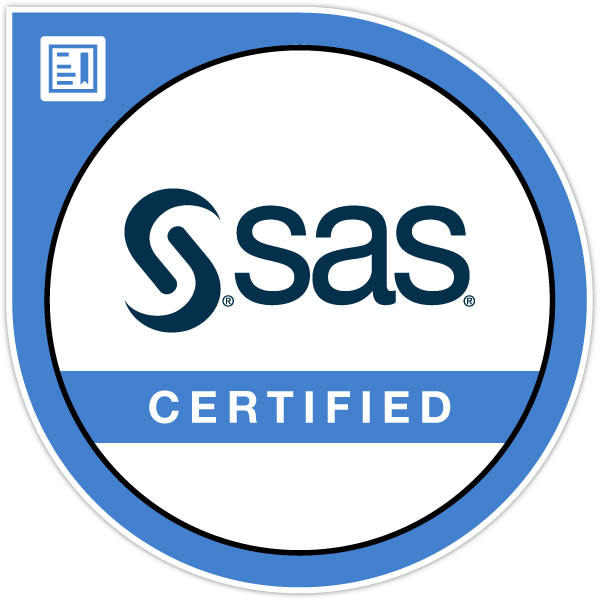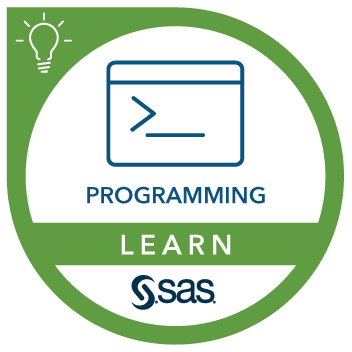SAS® Programming 1: Essentials
PROG1 : PG1V2
This course is for users who want to learn how to write SAS programs to access, explore, prepare, and analyze data. It is the entry point to learning SAS programming for data science, machine learning, and artificial intelligence. It is a prerequisite to many other SAS courses. If you do not plan to write SAS programs and you prefer a point-and-click interface, you should attend the SAS® Enterprise Guide® 1: Querying and Reporting course.
Learn How To
- Use SAS Studio and SAS Enterprise Guide to write and submit SAS programs.
- Access SAS, Microsoft Excel, and text data.
- Explore and validate data.
- Prepare data by subsetting rows and computing new columns.
- Analyze and report on data.
- Export data and results to Excel, PDF, and other formats.
- Use SQL in SAS to query and join tables.
Who Should Attend
Anyone starting to write SAS programs
Prerequisites
Before attending this course, you should have experience using computer software. Specifically, you should:
- Understand file structures and system commands on your operating systems.
- Be able to access data files on your operating systems.
SAS Products Covered
Base SAS
Course Outline
Essentials
- The SAS programming process.
- Using SAS programming tools.
- Understanding SAS syntax.
- Understanding SAS data.
- Accessing data through libraries.
- Importing data into SAS.
- Exploring data.
- Filtering rows.
- Formatting columns.
- Sorting data and removing duplicates.
- Reading and filtering data.
- Computing new columns.
- Conditional processing.
- Enhancing reports with titles, footnotes, and labels.
- Creating frequency reports.
- Creating summary statistics reports.
- Exporting data.
- Exporting reports.
- Using Structured Query Language in SAS.
- Joining tables using SQL in SAS.
Live Class Schedule
Duration: 21 hours
Step into our live classes and experience a dynamic learning environment where you can ask questions, share ideas, and connect with your instructor and classmates. With on-demand lab hours, you can explore the material at your own pace. Our globally acclaimed instructors will motivate you to think bigger, so you can take what you've learned and achieve your biggest goals.
15-19 DEC 2025
Live Web, US
1:00 PM-4:30 PM EST
English
2,175 USD
05-09 JAN 2026
Live Web, US
1:00 PM-4:30 PM EST
English
2,400 USD
12-16 JAN 2026
Live Web, US
9:30 AM-2:30 PM EST
Spanish
2,175 USD
21-23 JAN 2026
Live Web, US
9:00 AM-5:00 PM EST
English
2,400 USD
02-06 FEB 2026
Live Web, US
1:00 PM-4:30 PM EST
English
2,400 USD
18-20 FEB 2026
Live Web, US
9:00 AM-5:00 PM EST
English
2,400 USD
02-06 MAR 2026
Live Web, US
1:00 PM-4:30 PM EST
English
2,400 USD
18-20 MAR 2026
Live Web, US
9:00 AM-5:00 PM EDT
English
2,400 USD
08-10 APR 2026
Live Web, US
9:00 AM-5:00 PM EDT
English
2,400 USD
04-08 MAY 2026
Live Web, US
10:30 AM-3:30 PM EDT
Spanish
2,175 USD
Private Training
Get training tailored specifically for your team, led by expert SAS instructors. Choose from virtual sessions, or training at your location (or ours). Perfect for teams seeking a customized curriculum and plenty of interaction with a SAS specialist. We'll schedule it at a time that works for you.
Mentoring Services
Take your training to the next level with personalized mentoring. While private training offers structured coursework, mentoring provides hands-on, real-time support from a subject matter expert. As you work with your own data, you'll receive expert guidance to help you uncover insights, unlock the full potential of your data, and make faster progress. Perfect for those looking to apply what they’ve learned and see quicker results.

This course helps prepare you to earn the following SAS Credentials:
SAS Certification Manager
SAS partners with Pearson VUE to provide you with the best possible certification experience.
Certification Resources



